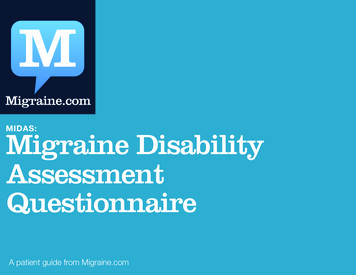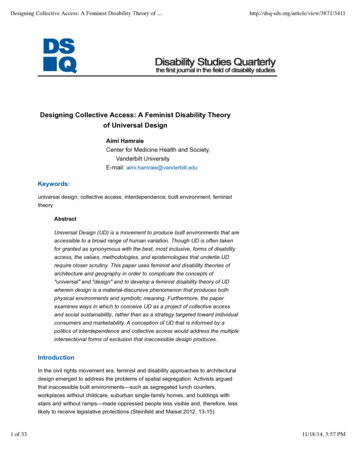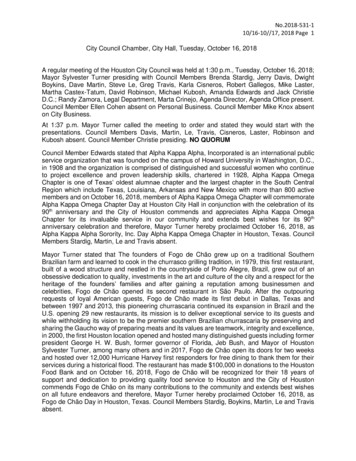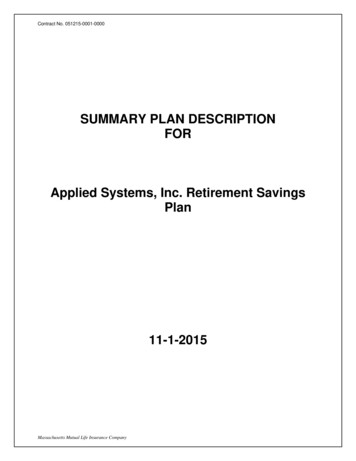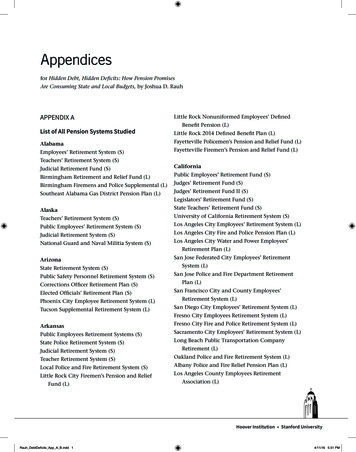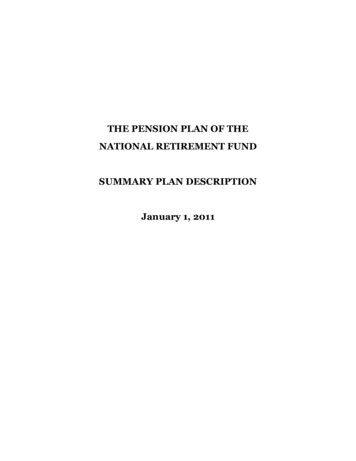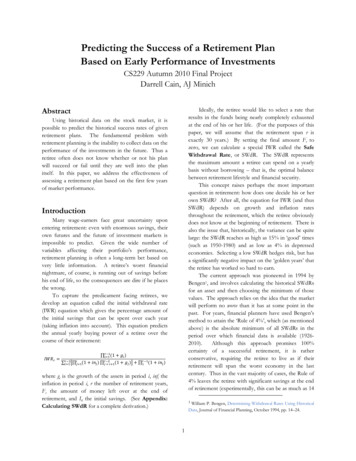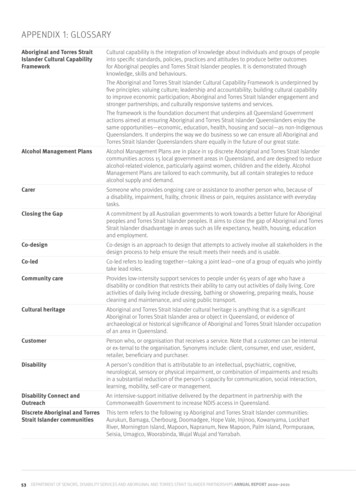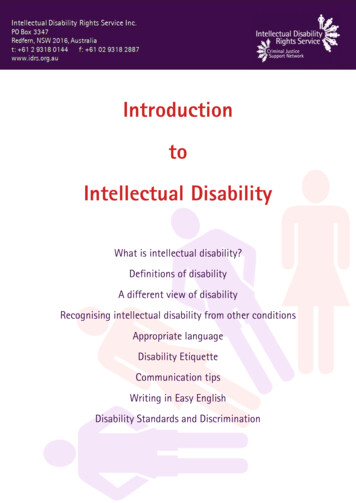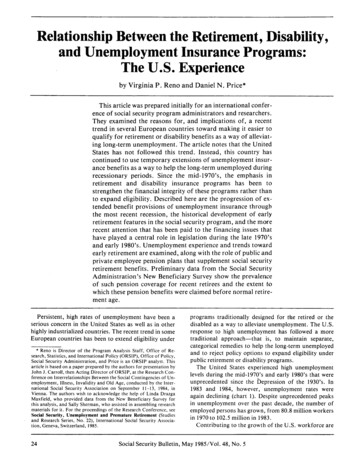
Transcription
Relationship Between the Retirement, Disability,and Unemployment Insurance Programs:The U.S. Experienceby Virginia P. Reno and Daniel N, Price*This article was prepared initially for an international conference of social security program administrators and researchers.They examined the reasons for, and implications of, a recenttrend in several European countries toward making it easier toqualify for retirement or disability benefits as a way of alleviating long-term unemployment. The article notes that the UnitedStates has not followed this trend. Instead, this country hascontinued to use temporary extensions of unemployment insurance benefits as a way to help the long-term unemployed duringrecessionary periods. Since the mid-1970’s, the emphasis inretirement and disability insurance programs has been tostrengthen the financial integrity of these programs rather thanto expand eligibility. Described here are the progression of extended benefit provisions of unemployment insurance throughthe most recent recession, the historical development of earlyretirement features in the social security program, and the morerecent attention that has been paid to the financing issues thathave played a central role in legislation during the late 1970’sand early 1980’s. Unemployment experience and trends towardearly retirement are examined, along with the role of public andprivate employee pension plans that supplement social securityretirement benefits. Preliminary data from the Social SecurityAdministration’sNew Beneficiary Survey show the prevalenceof such pension coverage for recent retirees and the extent bwhich these pension benefits were claimed before normal retirement age.Persistent, high rates of unemployment have been aserious concern in the United States as well as in otherhighly industrialized countries. The recent trend in someEuropean countries has bekn to extend eligibility under* Reno is Director of the Program Analysis Staff, Office of Research, Statistics, and International Policy (ORSIP), Office of Policy,Social Security Administration,and Price is an ORSIP analyst. Thisarticle is based on a paper prepared by the authors for presentation byJohn J. Carroll, then Acting Director of ORSIP, at the Research Conference on Interrelationships Between the Social Contingencies of Unemployment, Illness, Invalidity and Old Age, conducted by the International Social Security Association on September 11-13, 1984, inVienna. The authors wish to acknowledge the help of Linda DrazgaMaxfield, who provided data from the New Beneficiary Survey forthis analysis, and Sally Sherman, who assisted in assembling researchmaterials for it. For the proceedings of the Research Conference, seeSocial Security, Unemployment and Premalure Retirement (Studiesand Research Series, No. 22), International Social Security Association, Geneva, Switzerland, 1985.24programs traditionally designed for the retired or thedisabled as a way to alleviate unemployment. The U.S.response to high unemployment has followed a moretraditional approach-that is, to maintain separate,categorical remedies to help the long-term unemployedand to reject policy options to expand eligibility underpublic retirement or disability programs.The United States experienced high unemploymentlevels during the mid-1970’s and early 1980’s that wereunprecedented since the depression of the 1930’s. In1983 and 1984, however, unemployment rates wereagain declining (chart 1). Despite unprecedented peaksin unemployment over the past decade, the number ofemployed persons has grown, from 80.8 million workersin 1970to 102.5 million in 1983.Contributing to the growth of the U.S. workforce areSocial Security Bulletin, May 1985/Vol. 48, No. 5
Chart 1. - Quarterly unemployment rates for total U.S. civilian labor force and forolder workers, 1965-84Unemploymentrate percent):.: ‘.;:.::::::.109;:l .l .l:.:.::sl:.:.a:8,:.::,l . :.l .**‘.:*. .l:’‘f.:’.:.:l:79.:Age 16or older ocial Security Bulletin, May 1985/Vol. 48, No. 5I 982198425
the large number of persons born in the 20 years following World War II. This “baby-boom” generationreached adulthood and joined the workforce in the1970’s and early 1980’s. In addition, growing proportions of women have been entering and remaining in theworkforce. The large number of new workers has challenged the capacity of the U.S. economy to provideenough jobs, particularly in economic downturns. Therecent economic recovery, however, has brought adecline in unemployment from a high of 10.6 percent inthe last quarter of 1982to 7.1 percent in June 1984.This article describes the response of U.S. socialinsurance programs to the economic problems of the1970’s and early 1980’s. The policy response has been tomaintain separate and distinct remedies for unemployedworkers in the unemployment insurance program and toenact changes in the old-age, survivors, and disabilityinsurance (OASDI) program to stabilize both the longterm and short-term financing of those programs.The first section of this article describes the U.S.unemployment insurance program and documents theways in which temporary extensions of unemploymentbenefits have been provided in every major recessionsince the late 1950’s. It also describes briefly the experience of older workers under the unemployment insurance program and changes that recently have beenintroduced to limit payment of unemployment benefitsto older workers who receive retirement benefits.The second section, which summarizes OASDI policychanges, notes that the United States has not expandedearly retirement provisions under the social securityprogram since 1961, when reduced benefits were firstmade available to men at age 62. The 1961 change wasmade, in part, to help alleviate unemployment of oldermen during the 1961 recession. But during the 1970’sand early 1980’s, when the United States again experienced high rates of unemployment, both long-range andshort-range OASDI financing problems required attention and forestalled any interest in expanding earlyretirement options. In fact, the 1983Amendments to theSocial Security ,Act changed future retirement-agepolicy to encourage later retirement and, in that way, tohelp control the long-range cost of the program. TheOASDI program is financed almost exclusively fromearmarked taxes, primarily payroll taxes levied equallyon employees and employers. A sound long-term balance between projected revenues and projected programcosts is essential in maintaining public confidence in theprogram.The third section reports briefly on U.S. retirementtrends during the 1970’s and early 1980’s and notes thatan increasing proportion of men are leaving the laborforce before age 62, even though social security policyhas not been changed to encourage such a trend. Thefourth section describes briefly the private and publicemployee pension systems in the United States. These26pension plans, which typically are designed to supplement social security, often provide retirement benefitsbefore age 62. The section also presents findings fromthe Social Security Administration’s New BeneficiarySurvey indicating that significant numbers of men andwomen who draw retirement benefitsunder social security have begun receiving other pensions before age 62.Unemployment CompensationPolicy ResponsesUnemployment rates in the United States declinedthroughout most of 1983 and again in 1984. The 7.1percent rate of June 1984was still higher than desirable,but was clearly an improvement over the 10.6-percentrate experienced in the last quarter of 1982. The recenthigh unemployment rates prompted government action,resulting in Federal Supplemental Compensation, atemporary extension of unemployment insurancebenefits to help the long-term unemployed. This sectionbriefly describes the current unemployment insurancesystem, the evolution of programs that extend benefitduration when unemployment becomes severe, and therelationship of unemployment insurance to problemsexperienced by older unemployed workers.The Basic UnemploymentInsurance SystemUnemployment insurance is a Federal-State programestablished by the Social Security Act of 1935. EachState operates its own program under its own law withinnational guidelines. Standards are set under the Federallaw to assure that each State participating in theprogram has an insurance system that is financiallysound and fairly administered. There are no Federalrequirements concerning benefit amount or duration.Federal loans are available to the States when their ownfunds are inadequate to meet current claims forbenefits.Benefits are financed from State taxes paid byemployers on workers’ earnings up to an annual maximum. A few States also tax employees. The tax ratevaries by industry and employer, according to the firm’sprevious experience in maintaining a stable workforce.Funds for administration are provided through aFederal payroll tax on employers. The Federal payrolltax rate was 3.5 percent of covered earnings of the employer’s workers through 1984. However, employerscould credit toward the Federal tax (up to 2.7 percent ofthe 3.5 percent) the State tax payments and savingsunder their plan for maintaining labor-force stability.After December 3 1, 1984, the Federal tax rate increasedto 6.2 percent and the maximum credit rose to 5.4percent, so the net Federal tax continues to be 0.8percent.Social Security Bulletin, May 1985/Vol. 48, No. 5
The main objective of unemployment insurance is toprovide, as a matter of right, partial wage replacementfor temporary periods of involuntary unemployment. *It also is intended to stabilize the economy during recessions by maintaining purchasing power, and prevent thedispersal of an employer’s trained workforce, the sacrifice of skills, and the breakdown of labor standardsduring temporary unemployment.About 97 percent of all wage and salary workers arecovered by unemployment insurance. Most of thesepersons are covered under the State programs, althoughspecial Federal programs protect Federal employees,members of the military, and railroad workers. Somepersons fail to meet the coverage or eligibility requirements needed to receive benefits because they have aninsufficient attachment to the labor force-such assome farm, domestic, and casual workers-or are newjob entrants. Self-employed workers are excluded fromthe law.To receive unemployment benefits while out of work,a covered individual must meet eligibility criteria. Ingeneral, the worker must:have been employed in at least two quarters duringa recent period, called the base period, and haveearned specified minimum dollar amounts or haveworked for a specific number of weeks;show that he or she is able and willing to take ajob; andbe involuntarily unemployed.Benefits may be postponed, reduced, or cancelled undercertain conditions of voluntary job separation,discharge for misconduct, refusal of a suitable joboffer, or unemployment due to a labor dispute, receiptof other income, or seasonal unemployment.A weekly benefit is generally payable in most Statesafter 1 uncompensated “waiting” week. Some States donot require a waiting period. The benefit generallyamounts to about half the worker’s wage, with a somewhat higher proportion going to lower paid workers insome States and an additional dependents’ allowanceavailable in 13 of the 50 States and the District ofColumbia. In all the States, the weekly benefit may notexceed a specified State maximum amount. This maximum is indexed with changes in wages in 35 of theStates.Benefits are most commonly payable for a maximumof 26 weeks, though the potential duration may beshorter in most States if the worker has had insufficientattachment to the labor force. Benefits have beenextended beyond the 26-week duration of the basic program a number of times during economic downturns.1 William Haber and Merrill G. Murray,in the American Economy, 1966, page 26.UnemploymentInsuranceUnemployment Insurance for theLong-Term UnemployedAlthough unemployment insurance is basicallyintended to provide a partial, wage-related benefit forshort-term temporary periods of unemployment, cyclicchanges in the economy and recognition of structuralunemployment have caused the Federal Government toextend the duration of benefits a number of timesduring the past 25 years. This section documents theways in which the Federal Government has providedextensions of unemployment insurance benefits in everymajor recession since 1958.2Temporary program of Federal loans to States,195849. During the recession of 1958-59, the 1958Temporary Unemployment Compensation Act provided a voluntary program under which States could makeagreements with the Secretary of Labor to extend benefits for up to 13 additional weeks to workers who hadexhausted their regular benefits (which usually last 26weeks). The extended benefit amount was the same asthe regular amount. The program was financed byinterest-free loans from the Federal Government, to berepaid later by the States.Seventeen States participated in the program and another five paid additional benefits under their own programs. In all, 600 million was paid in extended benefitsduring 1958-59 to 2 million workers in the 22 States.3Participation was limited because of the repayment requirement.Temporary program of extended benefits, 1961-62.During the 1961 recession, the Temporary ExtendedUnemployment Compensation Act (TEUC) of 1961 extended benefits nationwide for up to 13 weeks topersons who had exhausted benefits under the regularprogram. The TEUC program was financed by a temporary addition to the Federal unemployment insurancepayroll tax. It paid 817 million in benefits during1961-62 to about 2.8 million persons.Permanent program of extended benefits activated byhigh unemployment, 1970 to date. The Extended Unemployment Compensation Act of 1970 was the culmination of a number of bills considered during the 1960’sto initiate a permanent program of extended benefits.The Extended Benefit (EB) program in 1970 followedthe earlier pattern of exteiiding the worker’s weeklybenefit for up to 13 weeks beyond the regular benefitduration of 26 weeks. The EB program is financed byunemployment insurance payroll taxes, half from theFederal and half from the State tax. All States arerequired to participate.Under the original program, extended benefits wereactivated nationally when the national insured unem2 National Commission on Unemployment Compensation, FinalReport, July 1980.3 Data on benefits paid are from unpublished tabulations by theUnemployment Insurance Service, Department of Labor.Social Security Bulletin, May 1985/Vol. 48, No. 527
ployment rate reached a specified level and were deactivated when the rate fell below a certain level. Even ifbenefits had not been activated nationally, they couldhave been paid in an individual State if that State experienced unusually high unemployment.From 1972 to 1975, Congress enacted temporarychanges in the specific provisions for activating anddeactivating the program. In 1981, the permanent EBprogram was narrowed in scope so that it now is activated only on a State-by-State basis; it is not activatednationally. And the State unemployment levels that activate the program were raised.The EB program has paid benefits every year since1970. Total payments through 1983 amounted to 17.2billion, about the same as the combined amount of allthe temporary extended benefit programs before andsince the advent of the EB program. Even with the EBprogram, .adverse employment conditions during the1970’s prompted the Federal Government to enactfurther extensions of benefits.Temporary program of supplemental benefits,1971-72. The Emergency Unemployment Compensation Act of 1971 provided an additional 13 weeks ofbenefits beyond the EB period (for a total of up to 52weeks of benefits) in States that experienced particularlyadverse unemployment conditions. Nearly 600 millionwas paid in 197l-72.Temporary program of supplemental benefits,1974-78. The Emergency Unemployment Compensation Act of 1974, plus three subsequent amendments,established the Federal Supplemental Benefits (FSB)program, which paid benefits from 1975 through early1978, This program provided a longer benefit durationthan ever before, up to a total of 65 weeks. The finalamendments to this program provided for general revenue financing, instead of the payroll tax financing thathad characterized all previous programs of extendedbenefits. Benefits amounting to more than 6.5 billionwere paid under the program.Temporary program of benefits for the uninsured,1974. In 1974, the Emergency Jobs and UnemploymentAssistance Act established a temporary program, not toextend benefits for insured workers, but to provideunemployment assistance to workers who were not covered under the regular program. This program, financedfrom general revenues, helped farm workers, domesticworkers, and State and local government workers andpaid 2.5 billion ‘in benefits. Experience with thisprogram led to coverage of these groups under theregular Federal-State system.Temporary program of supplemental benefits,1982-85. In 1982, the Federal Supplemental Compensation (FSC) program was enacted to provide benefits toworkers who exhausted their regular and extended benefits. Through March 1985, 8-14 weeks of FSC werepayable (plus extra benefits under certain circum-stances). Becauseextended benefits were paid only on aState-by-State basis, some workers start receiving FSCbenefits directly after exhausting their regular benefits.FSC benefits were financed from general revenues.About 7.5 billion was paid through March 1984. As ofMarch 1985, when the program ended, only three Stateswere paying extended benefits under the permanentprogram, but all the States were paying FSC benefits.Unemploymentand Older WorkersIn general, unemployment rates for older workers arelower than for the U.S. workforce as a whole. As shownin chart 1, historical unemployment rates for workersaged 55-64 and for workers aged 65 or older haveremained considerably below tKe rates for the entireworkforce aged 16 or older. In the last quarter of 1982,when the national unemployment rate reached 10.6percent, the rate for workers aged 55-64 was 5.3 percentand that for workers aged 65 or older was 3.4 percent.In recent years, the highest rates of unemployment havebeen experienced by young workers-teenagers andpersons in their early twenties-as the following annualaverage unemployment rates for 1982and 1983show.Allages.16orolder. .,,,,. . .,,,. . .20-24.25-54 . . . . . . . . . . . . . . . . . . . . . . . . . . . . . . . . . .( 16-1955 or olderThe young unemployed include a large number oflabor-force entrants and reentrants. The unemploymentinsurance program provides benefits to workers wholose their jobs and generally does not pay benefits topersons who lack recent covered work experience.The insured unemployment rate is used to measureexperience under the unemployment insurance programand is calculated as the proportion of workers coveredunder the program who file for unemployment insurance benefits. Older workers generally account for alarger proportion of the “insured unemployed” thanthey do of t’he total unemployed population. Daniel S.Hammermesh estimated that about 10 percent of theunemployed in 1977 were aged 55 or older but that 16percent of those claiming unemployment insurance wereconcentrated in those ages.4 Thus, the older unemployed appear to be more likely than their youngercounierparts to receive unemployment insurancebenefits.During the 1970’s, however, older unemployedworkers were likely to experience longer spells of unem4 Daniel S. Hammermesh, UnemploymentInsuranceand the OlderUpJohn Institute for Employment Research, 1980,pages 4-6.American,W.E.Social Security Bulletin, May 1985/Vol. 48, No. 5
ployment before finding work than was the case fortheir younger counterparts. During the period 1968-81,men aged 60 or older experienced an average of 16weeks of unemployment before finding work, whilemen aged 25-44 searched an average of 12 weeks beforedoing SO. Data from the extended benefit programs showwhether older workers are more likely than their younger counterparts to exhaust their regular benefits andturn to the special extended benefit programs. Duringthe recent economic downturn, older workers did notappear to rely disproportionately on the extendedbenefit programs. In July-August 1983, for example,persons aged 50 or older accounted for 19.4 percent ofthose receiving regular unemployment insurancebenefits but only 16.7 percent of those receiving extended benefits under the Federal Supplemental Compensation program.‘j Similar results are found in a March1984 study of FSC recipients for the U.S. Departmentof Labor. That study found that “The age and sexdistribution of FSC recipients was quite similar to thedistribution of unemployment insurance recipients whodid not receive these extended benefits. . . . This finding contrasts with the experience in the 1974-75 recession when extended benefit recipients were more likelyto be older and more likely to be women than othergroups of the insured unemployed.” ’During the 1960-61 recession, claimants under theextended benefit program were older than the recipientsof regular program benefits.8 Thus, the experienceduring the 1982-83 period represents a departure fromexperience in both the 1974-75 and 1960-61 periods,when recipients of extended benefits tended to be olderthan the recipients of regular unemployment benefits.Trade AdjustmentAssistanceBetween 1974 and 1981, a Federal program providedextended unemployment benefits to older workers(those aged 60 or older) whose job loss was caused byimports. These extended benefits for older workers werepart of a package of benefits and special allowances forworkers of all ages to assist in retraining, job search,and relocation expenses when their unemployment wasattributable to international trade. In 1974, the TradeReadjustment Allowances (TRA’s) provided for an augmented weekly unemployment benefit, generally highers Philip L. Rones, “The Labor Market Problems of OlderWorkers,” Monthly Labor Review, Department of Labor, May 1983,page 7.6 Background Material and Data on Programs within the Jurisdiction of the Committee on Ways and Means, U.S. House of Representatives, February 21, 1984, page264.’ Walter Corson, Characteristics of FSC I/II Recipients, Mathematica Policy Research, March 1984, page 2.* The Long Term Unemployed, Comparison with Regtlar Unemployment Insurance Claimants, Special TEUC Report Number 3,November 1965, page 12.than benefits under State law, and for an additionalduration of benefits, for a combined State and TRAduration of up to 52 weeks. An additional 26 weeks ofbenefits was provided for individuals who were in retraining programs and for workers who were at least 60years old.In 1981, the weekly TRA allowance was set at thesame amount as for regular State benefits and the basicduration was limited to 26 weeks. An additional 26weeks of benefits are payable to workers in retraining,but overall duration is limited to 52 weeks. The olderworker benefit was eliminated.Unemployment Benefits andRetirement BenefitsIn recent years, concern had been expressed thatpayment of unemployment benefits to retired workerswas unjustified based on the concept that retiredworkers are no longer in the labor force. In response tothis concern, Congress enacted a provision to offsetunemployment benefits against retirement benefits.Proposals have also been made to extend additionalunemployment benefits to older workers to encouragethem to remain in the labor force instead of retiringearly. No action has been taken on these latterproposals.Offset between unemployment and retirement benefits. Congress enacted in 1976, and amended in 1980, aprovision to offset unemployment insurance benefitsdollar for dollar by any pension the claimant receivesfrom his or her previous employment.9 The offset applies to social security retirement benefits as well as toprivate pensions.States have some latitude in determining how to applythe offset. It must apply if the private plan was providedby the same employer who provided unemployment insurance coverage for the worker and if the recent workfor that employer (in the unemployment insurance“base period”) counted toward the worker’s pensionrights. As of January 1984, many of the States appliedthe offset on a broader basis than required by the Federal law. In 22 States, the offset is applied even if the immediate work for the employer did not enhance theworker’s pension. In five other Statesand the District ofColumbia, the offset is applied to any private pension.The law requires that social security retirement benefitsalso serve to reduce the unemployment benefit amountseven if social security coverage in the “base period” didnot enhance the worker’s social security benefitamount. The Federal law allows each State to take intoaccount the effect of employee contributions to pensionplans in determining how to apply the offset.9 Unemployment Compensation Amendments of 1976 (Public Law94-566) and MultiemployerPension Plan Amendments Act of 1980(Public Law 96-364).Social Security Bulletin, May 1985/Vol. 48, No. 529
The offset applies only to retirement benefits basedon the worker’s own employment, not to spouse or survivor benefits. It is still to be resolved whether disabilitybenefits are to be treated as “pensions” or, “retirement” benefits and thus be subject to the offset.Proposals to extend unemployment benefits. Proposals have been made specifically to add benefits forolder unemployed workers to encourage them to remainin the workforce and forgo early retirement benefits.The Report of the National Commission on Unemployment Compensation recommended that an unemployment benefit lifetime reserve program be established toreward the labor-force attachment of older workers.This reserve would provide up to 52 weeks of extrabenefits to those aged 60-64 after they had used up theirnormal unemployment insurance entitlement. According to the Commission, such benefits would be important in maintaining and making the fullest use of theskills and experience of the labor force as well as in conserving social security funds.‘OAnother proposal outlined a series of alternative provisions for giving extra unemployment benefit protection to older workers. Up to 52 weeks of extra benefitswould be made available to workers as young as age 55.This proposal, made by Steve L. Barsby,” also emphasized the objective of strengthening the labor-force attachment of older workers and delaying their receipt ofsocial security retirement benefits. Thus far, little if anyaction has been taken to implement these types of proposals.The Social Security SystemThe basic OASDI (or social security) program forretirement and disability benefits is administered separately from the unemployment insurance program. Although they were both part of the same original act, theOASDI and unemployment insurance programs areadministered by separate Federal agencies and are considered by separate subcommittees of Congress.Early Retirement Options:RationaleEarly retirement with actuarially reduced benefitsbefore age 65 under social security was first madeavailable in 1956 for women and in 1961 for men. Noprogram changes since then have expanded the early retirement options. In 1956, the option for women toclaim benefits as early as age 62 was prompted mainlyby a concern for extending benefits to married women,who were often not old enough to receive benefits when1” National Commission on Unemployment Compensation, FinalReport, July 1980, page 71.tt Steve L. Barsby, “The UnemploymentExperience of OlderWorkers and the Transitionto Retirement,”UnemploymentCompensation Studies and Research, Volume 3, National Commission on Unemployment Compensation, July 1980, pages 73 l-33.30their husbands retired, and to women who becamewidowed before age 65. Although the Congress recognized that job opportunities were limited for olderwomen, the change was not primarily a response tounemployment. I2In 1961, when the same early retirement option wasextended to men, the United States was in a recessionand the unemployment level had reached 7 percent.Extending the early retirement option was seenas a wayto reduce unemployment among older workers. Thechange was in part a response to long-term technological unemployment, recognizing that persons wholost their jobs at older ages might never find otherwork.t3 To limit the cost of the early retirement option,benefits were permanently reduced by 5/9 of 1 percentfor each month of early receipt (or 20 percent if theywere claimed at age 62). The reduction in benefits forearly retirement was designed to take account of thelonger period benefits would be paid to early retirees sothat the long-range cost of paying benefits claimed atage 62 would be about the same as if the retiree hadwaited until age 65.Later in the 1960’s, when unemployment rates haddeclined, policy issuesabout older workers shifted fromconcerns about accessto benefits to the level of their reduced early retirement benefits. Large numbers of menand women continued to claim reduced benefits beforeage 65, and many of the early retirees had low benefitseven before the actuarial reduction was applied. A Social Security Advisory Council in 1965 considered achange in retirement-age policy to apply a less-thanactuarial reduction in early retirement benefits as a wayto raise the incomes of older workers who were forcedinto early retirement. But the Council had reservationsabout the cost and side-effects of a change that mightcreate a positive incentive to retire early. Instead ofrecommending the change, the Council asked the SocialSecurity Administration (SSA) to conduct studies tofind out why workers were claim
insurance programs to the economic problems of the 1970's and early 1980's. The policy response has been to maintain separate and distinct remedies for unemployed workers in the unemployment insurance program and to enact changes in the old-age, survivors, and disability insurance (OASDI) program to stabilize both the long-


